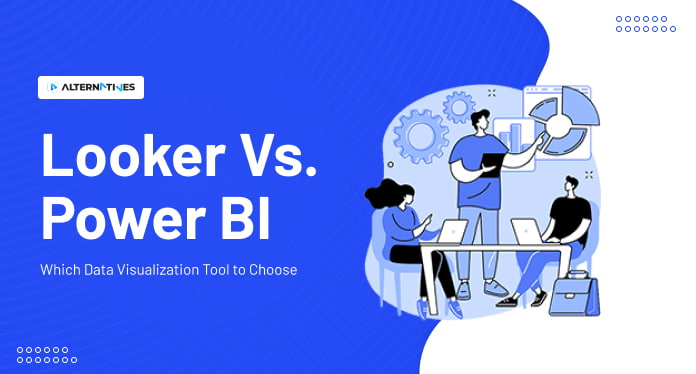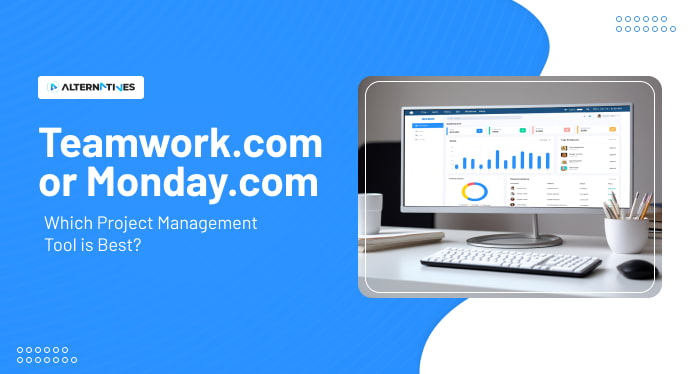Looker vs. Power BI: Which Data Visualization Tool to Choose?

Data visualization is a key element in the modern business world, allowing users to gain insights and make decisions based on data. With the rise of big data, businesses need powerful tools that can help them analyze and visualize their data to make informed decisions quickly. Looker and Power BI are two of the most popular data visualization tools available today, but which one should you choose for your business? In this article, we will compare Looker vs Power BI in terms of data sources, data connectivity, pricing, customer support and more. So, stay tuned.
A Quick Overview of Looker
Looker is a powerful business intelligence and data exploration platform. It enables users to analyze and visualize data, fostering informed decision-making. Looker’s features include customizable dashboards, real-time collaboration, and a user-friendly interface. Businesses seeking similar tools should explore Looker alternatives to find the right fit for their data analytics needs.
A Quick Overview of Power BI
Power BI is a robust business analytics tool by Microsoft, that allows users to transform raw data into actionable insights. Its features include interactive dashboards, data connectivity, and AI-driven analytics. With user-friendly interfaces, Power BI facilitates data exploration and collaboration. Those seeking alternatives to Power BI can explore similar tools to find the ideal solution for their business intelligence requirements.
Feature Comparison For Looker Vs Power BI
| Feature | Looker | Power BI |
| Data Visualization | Looker provides interactive and customizable visualizations for effective data exploration. | Power BI offers a wide range of dynamic and customizable visualizations to enhance data representation. |
| Dashboards | Looker allows the creation of intuitive and tailored dashboards for real-time monitoring. | Power BI empowers users to design interactive dashboards with drag-and-drop functionality. |
| Data Connectivity | Looker seamlessly connects to various data sources, fostering comprehensive data integration. | Power BI supports extensive data connectivity, enabling users to import data from diverse sources. |
| Collaboration | Looker promotes real-time collaboration with features like data sharing and collaborative analytics. | Power BI facilitates team collaboration through shared reports, dashboards, and annotations. |
| Query Language | Looker employs LookML, a data modelling language, simplifying complex queries and ensuring data consistency. | Power BI uses Power Query, enabling users to transform and shape data efficiently with a user-friendly interface. |
| AI Integration | Looker integrates with AI tools, allowing users to leverage machine learning for advanced analytics. | Power BI incorporates AI features for predictive analytics, anomaly detection, and natural language queries. |
| Mobile Access | Looker provides mobile apps, ensuring users have access to insights on the go for timely decision-making. | Power BI offers mobile compatibility, allowing users to access reports and dashboards from any device. |
| Data Security | Looker emphasizes data security with features like encryption, access controls, and auditing capabilities. | Power BI ensures data security through role-based access, encryption, and compliance with industry standards. |
| Customization | Looker allows extensive customization of reports, dashboards, and visualizations to meet specific business needs. | Power BI offers a high level of customization, allowing users to tailor reports and dashboards to their preferences. |
| Scalability | Looker is scalable, adapting to the growing data needs of businesses without compromising performance. | Power BI scales effectively, accommodating increased data volumes and user demands for seamless scalability. |
| Natural Language Processing | Looker incorporates natural language processing for intuitive querying, allowing users to interact with data using conversational language. | Power BI leverages natural language queries, enabling users to ask questions and receive insights conversationally, simplifying data exploration. |
| Data Governance | Looker ensures robust data governance with version control, audit logs, and data lineage tracking. | Power BI offers robust data governance features, including data lineage, access controls, and compliance with regulatory standards. |
| Data Discovery | Looker supports data discovery through guided exploration, empowering users to uncover valuable insights and trends within their datasets. | Power BI facilitates data discovery with intuitive features, enabling users to explore and analyze data effortlessly for actionable business intelligence. |
| Cost Model | Looker offers three subscription plans viewer, standard, and developer and the pricing starts at $30 per month to $215 per month. | Coming to Power BI offers one free plan and 5 paid subscription plans such as Power BI Pro, Power BI Premium, etc. The pricing starts at $10 per month. |
| User Training | Looker offers training resources and a user-friendly interface to streamline the learning curve for new users. | Power BI provides extensive training materials and a user-friendly interface for quick adoption by users at all skill levels. |
Looker Vs Power BI: Feature Comparison
1. Data Visualization
Combining Looker and Power BI leverages advanced reporting capabilities, providing unparalleled insights. Looker excels with its LookML language for efficient, consistent data modeling, while Power BI impresses with AI-driven analytics for predictive insights. Looker’s interactive visualizations offer in-depth exploration, complemented by Power BI’s dynamic and customizable reporting. Together, they offer a comprehensive reporting solution, enabling businesses to merge the strengths of Looker’s modelling precision with Power BI’s AI prowess for a robust and versatile approach to advanced reporting and data analytics.
2. Dashboards
Combining Looker and Power BI enhances dashboard capabilities, delivering a powerful data visualization duo. Looker empowers users with intuitive, customizable dashboards for real-time insights. Meanwhile, Power BI’s drag-and-drop functionality ensures seamless dashboard creation with diverse visualizations. The integration of Looker’s tailored monitoring and Power BI’s dynamic design offers a comprehensive solution. Businesses benefit from a unified approach, leveraging Looker’s precision and Power BI’s flexibility to create insightful dashboards that cater to varied data visualization needs.
3. Data Connectivity
Looker seamlessly integrates with diverse data sources, ensuring comprehensive data assimilation. Its LookML language simplifies complex queries for consistent analysis. Power BI excels with extensive data connectivity, offering a user-friendly Power Query interface for efficient data import. The unified power of Looker’s integration versatility and Power BI’s connectivity options creates a comprehensive solution. Together, they streamline data integration, providing users with a flexible and efficient approach to accessing and analyzing data from various sources.
4. Collaboration
The collaboration features of Looker and Power BI, when combined, foster a dynamic environment for shared insights and teamwork. Looker promotes real-time collaboration through data sharing and collaborative analytics, enhancing team synergy. Power BI facilitates seamless team collaboration by enabling the sharing of reports, dashboards, and annotations. The integration of Looker’s collaborative analytics and Power BI’s shared resources creates a comprehensive platform. Businesses benefit from enhanced teamwork and knowledge sharing, ensuring collective insights drive informed decision-making in a collaborative and streamlined manner.
5. Query Language
Looker employs LookML, a powerful data modeling language, simplifying complex queries and ensuring data consistency across analyses. Power BI utilizes Power Query, offering a user-friendly interface for efficient data transformation and shaping. The synergy of Looker’s modelling precision with Power BI’s intuitive interface provides users with a versatile and comprehensive approach to querying, ensuring efficient data extraction and exploration for informed decision-making.
6. AI Integration
The combination of Looker and Power BI elevates analytics with robust AI integration. Looker seamlessly integrates with AI tools, enabling users to leverage machine learning for advanced analytics and predictive insights. Power BI incorporates AI features for predictive analytics, anomaly detection, and natural language queries. Together, they offer a comprehensive solution, merging Looker’s focus on machine learning capabilities with Power BI’s AI-driven analytics, providing users with a powerful and intelligent platform for extracting valuable insights from their data.
7. Mobile Access
The combined mobile access features of Looker and Power BI provide users with on-the-go data accessibility. Looker offers dedicated mobile apps, ensuring users can stay connected with critical insights anytime, anywhere. Power BI extends mobile compatibility, allowing users to access reports and dashboards seamlessly across devices. This integration ensures a flexible and responsive user experience, allowing businesses to make data-driven decisions conveniently, whether in the office or on the move.
8. Data Security
The combined data security features of Looker and Power BI ensure robust protection for sensitive information. Looker prioritizes data security with encryption, access controls, and auditing capabilities, ensuring secure data management. Power BI complements this with role-based access, encryption, and compliance adherence. Together, they provide a comprehensive approach to data security, offering businesses a solid foundation for safeguarding their information and maintaining the integrity and confidentiality of their data assets.
9. Customization
Looker allows extensive customization of reports, dashboards, and visualizations, ensuring tailored insights. Power BI offers a high level of customization, allowing users to personalize reports and dashboards to meet specific preferences. Together, they provide a versatile platform, catering to diverse business needs. Users benefit from the flexibility of Looker’s precision and Power BI’s adaptability, creating a customized analytics environment for optimal data interpretation and decision-making.
10. Scalability
Combining Looker and Power BI offers a scalable analytics solution that adapts to growing business needs. Looker’s scalability ensures it accommodates increased data volumes without compromising performance. Power BI complements this with effective scaling capabilities, maintaining seamless performance as organizations expand. Together, they provide businesses with a comprehensive and scalable analytics environment, ensuring that users can analyze and interpret data efficiently, regardless of the scale, and supporting the evolving data requirements of growing enterprises.
11. Natural Language Processing
The combined natural language processing (NLP) features of Looker and Power BI create an intuitive querying experience. Looker incorporates NLP for user-friendly interaction with data, allowing users to analyze data using conversational language. Power BI, too, leverages NLP, enabling users to ask questions and receive insights conversationally. Together, they offer a comprehensive NLP solution, ensuring that users can interact with data effortlessly, and making analytics accessible to users with varying levels of technical expertise.
12. Data Governance
Looker ensures comprehensive data governance with version control, audit logs, and data lineage tracking, ensuring data accuracy. Power BI reinforces governance through data lineage, access controls, and compliance with regulatory standards, promoting secure and compliant data management. Together, they provide a solid foundation for businesses to uphold data integrity, adhere to compliance requirements, and foster transparent and accountable data practices.
13. Data Discovery
The combined data discovery features of Looker and Power BI offer a dynamic approach to uncovering valuable insights. Looker facilitates data discovery through guided exploration, empowering users to uncover trends within their datasets intuitively. Power BI complements this with intuitive features that enable users to explore and analyze data effortlessly. Together, they provide a comprehensive data discovery platform, ensuring users can extract meaningful insights and make informed decisions with ease, fostering a data-driven culture within organizations.
14. Cost Model
When it comes to Looker's pricing plan, it provides three subscription options: Viewer, Standard, and Developer, with pricing ranging from $30 to $215 per month. Additionally, there is a pay-as-you-go plan starting at $5,000 per month. In contrast, with regards to Power BI's pricing offers a free plan and five paid subscriptions, including Power BI Pro and Power BI Premium, with pricing starting at $10 per month.
15. User Training
Combining Looker and Power BI ensures a user-friendly experience with robust training features. Looker provides training resources and an intuitive interface, simplifying the learning curve for new users. Power BI offers extensive training materials and a user-friendly interface, accommodating users at all skill levels. Together, they create a comprehensive training environment, ensuring users can quickly adapt to the platforms, maximizing their proficiency and empowering them to harness the full potential of Looker and Power BI for effective data analysis and reporting.
Looker Vs Power BI – Which is Better?
Choosing between Looker and Power BI depends on specific business needs. Each platform has its unique strengths and features, catering to diverse requirements in the realm of business intelligence and analytics.
With regards to Looker Reviews, it is a user-friendly data analytics platform that excels in data exploration and visualization. Conversely, Power BI's reviews highlight its notable distinction in seamlessly integrating with various Microsoft products, rendering it the top choice for numerous organizations. In the following comparisons, we’ll highlight distinct advantages of Looker and Power BI, helping businesses make informed decisions based on their priorities and preferences.
What makes Looker a better option
- Intuitive data modelling facilitates efficient analysis.
- Real-time collaboration enhances teamwork for collective insights.
- Dedicated mobile apps ensure on-the-go accessibility for timely decisions.
- Robust data governance features include version control and comprehensive lineage tracking.
- Extensive customization options for tailored reports and dashboards.
What makes Power BI a better option
- Integrates AI for predictive analytics and anomaly detection.
- Adaptable pricing plans cater to varied business requirements effectively.
- Supports diverse data sources for comprehensive integration capabilities.
- Power Query simplifies data transformation with a user-friendly interface.
- Effective scaling accommodates increased data volumes for continued seamless performance.
Frequently Asked Questions
What is Looker?
Looker is a comprehensive business intelligence and data exploration platform. It empowers users to delve into data analysis, create dynamic visualizations, and interpret complex datasets. Looker’s focus on providing a user-friendly interface enhances accessibility for individuals across organizations, fostering data-driven decision-making.
What is Power BI?
Power BI, developed by Microsoft, is a robust business analytics tool. It enables users to connect to various data sources, analyze information, and generate interactive reports and dashboards. Power BI’s integration with Microsoft’s ecosystem enhances collaboration and data sharing, making it a versatile solution for businesses seeking actionable insights.
What is Looker used for?
Looker is primarily used for data analysis and exploration. It allows users to create customized reports and dashboards, facilitating a deeper understanding of complex datasets. Additionally, Looker promotes collaboration and the generation of real-time insights, making it a valuable tool for businesses aiming to enhance decision-making processes.
What is Power BI used for?
Power BI serves as a powerful tool for business analytics. Users can seamlessly connect to diverse data sources, transforming raw data into visually compelling reports and dashboards. The interactive nature of Power BI facilitates data exploration and sharing, enabling organizations to make informed decisions based on a comprehensive understanding of their data.
Is Looker and Power BI free?
Yes, Power BI offer free versions with certain limitations. However, Looker doesn't provide any free trial period for users to explore its features, while Power BI offers a free service tier with basic functionality. Users have the option to upgrade to more advanced, feature-rich paid plans based on their specific business requirements.
What are the data sources supported by Looker and Power BI?
Looker supports a wide range of data sources, including SQL databases, NoSQL databases, and cloud-based data warehouses. Power BI supports a similar range of data sources, including Excel spreadsheets, cloud-based data warehouses, and other cloud-based services.
Conclusion
In conclusion, Looker and Power BI are powerful business intelligence tools, each with its strengths. Looker excels in intuitive data modeling and collaborative analytics, fostering real-time insights. Power BI, a Microsoft product, offers robust AI integration and extensive data connectivity. The choice between Looker and Power BI depends on specific business needs, ensuring organizations can leverage the platform that aligns best with their data analytics and reporting requirements.



